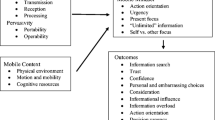Abstract
Business pundits have enthusiastically prognosticated about a seamless, mobile world where commerce occurs on an anywhere, anytime basis. This type of commerce has been referred to as mobile commerce or, more simply, m-commerce. However, there have been relatively few attempts to systematically explore the opportunities and challenges posed by m-commerce. This article investigates the implications of m-commerce for markets and marketing by means of a formal conceptualization of m-commerce, a space-time matrix that delineates the impact of mobile technologies, and a taxonomy of m-commerce applications.
Similar content being viewed by others
References
Balasubramanian, Sridhar. 1998. “Mail vs. Mall: A Strategic Analysis of Competition Between Direct Marketers and Conventional Retailers.”Marketing Science 17 (Summer): 181–195.
Becker, Gary S. 1965. “A Theory of the Allocation of Time.”Economic Journal 75 (September): 493–517.
Bergeron, Bryan. 2001.The Wireless Web: How to Develop and Execute a Winning Wireless Strategy. New York: McGraw-Hill.
Came, Barry. 2000. “Wireless Nation: Welcome to Finland, Where Nearly Everyone Has a Cellphone.”Macleans, December 4, p. 41.
Cantillon, Richard. 1931.Essai Sur la Nature du Commerce en Général. Edited and translated by H. Higgs. London: Macmillan. (Original publication 1755).
Condillac, Etienne Bonnot. 1776.Le Commerce et le Gouvernement considérés relativement l’un à l’autre. Paris: Jombert et Cellot.
Darby, Michael and Edi Karni. 1973. “Free Competition and the Optimal Amount of Fraud.”Journal of Law and Economics 16 (April): 67–86.
d’Aspremont, Claude, J. Jaskold Gabszewicz, and Jaques-François Thisse. 1979. “On Hotelling’s ‘Stability in Competition’.”Econometrica 47 (September): 1145–1150.
DeSerpa, Allan C. 1971. “A Theory of the Economics of Time.”The Economic Journal 81 (December): 828–846.
DiPippo, Lisa Congiser and Victor Fay Wolfe. 1995. “Real-Time Data-bases.” Working Paper. University of Rhode Island Department of Computer Science and Statistics.
Ghez, Gilbert R. and Gary S. Becker. 1975.The Allocation of Time and Goods Over the Life Cycle. New York: Columbia University Press.
Hotelling, Harold. 1929. “Stability in Competition.”Economic Journal 39 (March): 41–57.
Huff, David L. 1964. “Defining and Estimating a Trading Area.”Journal of Marketing 28 (July): 34–38.
Kalakota, Ravi and Marcia Robinson. 2002.M-Business: The Race to Mobility. New York: McGraw-Hill.
Keen, Peter G. W. and Ron Mackintosh. 2001.The Freedom Economy. Berkeley, CA: Osborne/McGraw-Hill.
Konana, Prabhudev and Sudha Ram. 1998. “Transaction Management Mechanisms for Active and Real-Time Databases: A Comprehensive Protocol and a Performance Study.”Journal of Systems and Software 42 (September): 205–225.
Lamont, Douglas. 2001.Conquering the Wireless World. Oxford, UK: Capstone.
Nelson, Phillip. 1970. “Information and Consumer Behavior.”Journal of Political Economy 78 (July): 311–329.
—. 1974. “Advertising as Information.”Journal of Political Economy 81 (December): 729–754.
Newell, Frederick and Katherine Newell Lemon. 2001.Wireless Rules: New Marketing Strategies for Customer Relationship Management Anytime, Anywhere. New York: McGraw-Hill.
Ohta, Hiroshi. 1993. “Introduction: In Honour of Melvin L. Greenhut.” InDoes Economic Space Matter: Essays in Honour of Melvin L. Greenhut. Eds. Hiroshi Ohta and Jacques-François Thisse. New York: St. Martin’s. 1–18.
Owen, John D. 1970.The Price of Leisure. Montreal: McGill-Queen’s University Press.
Peterson, Robert A. and Sridhar Balasubramanian. 2002. “Retailing in the 21st Century: Reflections and Prologue to Research.”Journal of Retailing 78 (Spring): 9–16.
——, and Bart J. Bronnenberg. 1997. “Exploring the Implications of the Internet for Consumer Marketing.”Journal of the Academy of Marketing Science 25 (Fall): 329–346.
Predöhl, Andreas. 1928. “The Theory of Location in Its Relation to General Economics.”Journal of Political Economy 36 (September): 371–390.
Shackle, George L. S. 1958.Time in Economics. Amsterdam: North-Holland.
Sharp, Clifford. 1981.The Economics of Time. New York: John Wiley.
Sheth, Jagdish N. and Rajendra Sisodia. 1999. “Revisiting Marketing’s Lawlike Generalizations.”Journal of the Academy of Marketing Science 27 (Winter): 71–87.
Sinha, Indrajit. 2000. “Cost Transparency: The Net’s Real Threat to Prices and Brands.”Harvard Business Review 78 (March–April): 43–54.
Spasojevic, Mirjana and Tim Kindberg. 2001. “A Study of an Augmented Museum Experience.” Working Report HPL-2001-178. Internet and Mobile Systems Laboratory, Hewlett-Packard Laboratories.
Von Thünen, Johann H. 1966.The Isolated State. Trans. Carla M. Wartenberg. Ed. Peter Hall. Oxford, UK: Pergamon. (Original publication 1826)
Weber, Alfred. 1929.Theory of the Location of Industries. Trans. C. J. Friedrich. Chicago: University of Chicago Press. (Original publication 1909)
Author information
Authors and Affiliations
Additional information
Sridhar Balasubramanian is assistant professor of marketing at the University of North Carolina at Chapel Hill. His interests generally lie in the areas of marketing strategy, e-business, and game theory. He has published in such journals asMarketing Science, Journal of Retailing, andJournal of the Academy of Marketing Science. His doctorate is from Yale University.
Robert A. Peterson holds the John T. Stuart III Centennial Chair in Business Administration and Charles C. Hurwitz Fellowship at The University of Texas at Austin. He is a former editor of theJournal of Marketing Research and theJournal of the Academy of Marketing Science. His more than 150 publications include nearly one dozen books and award-winning articles.
Sirkka L. Jarvenpaa holds the James L. Bayless/Rauscher Pierce Refsnes Chair in Business Administration at the McCombs School of Business, University of Texas at Austin, where she codirects the Center for Business, Technology & Law. She presently serves as the editor ofJournal of the Association for Information Systems. She is a founding member of the Global Round Table on Mobile Commerce Research, which held its inaugural meeting in Tokyo in May 2002.
Rights and permissions
About this article
Cite this article
Balasubramanian, S., Peterson, R.A. & Jarvenpaa, S.L. Exploring the implications of m-commerce for markets and marketing. J. of the Acad. Mark. Sci. 30, 348–361 (2002). https://doi.org/10.1177/009207002236910
Issue Date:
DOI: https://doi.org/10.1177/009207002236910




